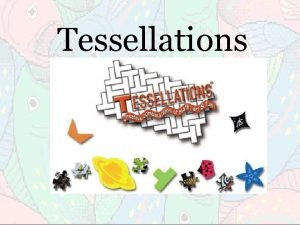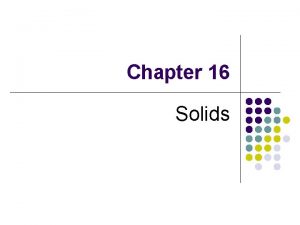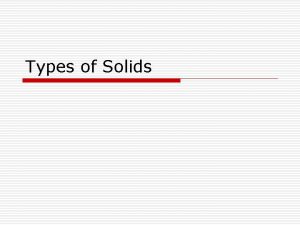Tessellated solids G 4 Tessellated Solid Generic solid




- Slides: 4

Tessellated solids • G 4 Tessellated. Solid – Generic solid defined by a number of facets (G 4 VFacet) • Facets can be triangular (G 4 Triangular. Facet) or quadrangular (G 4 Quadrangular. Facet) – Constructs especially important for conversion of complex geometrical shapes imported from CAD systems – But can also be explicitly defined: • By providing the vertices of the facets in anti-clock wise order, in absolute or relative reference frame – GDML binding • G 4 Extruded. Solid is re-implemented to internally use G 4 Tessellated. Solid. Geant 4 for Space Radiation Applications - M. Asai (SLAC) 1

Geometry updates – New solid library • • • An important effort was begun in the last few years to write a new solid library, reviewing at the algorithmic level most of the primitives and provides an enhanced, optimized and well-tested implementation to be shared among software packages. In most cases considerable performance improvement was achieved. – For example, the time required to compute intersections with the tessellated solid was dramatically reduced with the adoption of spatial partitioning for composing facets into a 3 D grid of voxels. Such techniques allow speedup factors of a few thousand for relatively complex structures having of order 100 k to millions of facets, which is typical for geometry descriptions imported from CAD drawings. – Consequently, it is now possible to use tessellated geometries for tuning the precision in simulation by increasing the mesh resolution, something that was not possible before. n i w e N 4. 0 v 1 Geant 4 for Space Radiation Applications - M. Asai (SLAC) 2

New “multi-union” solid • • • In addition to a full set of highly optimized primitives and a tessellated solid, the library includes a new "multi-union” structure implementing a composite set of many solids to be placed in 3 D space. This differs from the simple technique based on Boolean unions, with the aim of providing excellent scalability on the number of constituent solids. The multi-union adopts a similar voxelization technique to partition 3 D space, allowing dramatically improved speed and scalability over the original implementation based on Boolean unions. in w e N 0. 4 v 1 Geant 4 for Space Radiation Applications - M. Asai (SLAC) 3

G 4 Multi. Union* munion_solid = new G 4 Multi. Union(“United. Boxes"); for( int i=0 ; I < n. Node ; i++) { G 4 Box* a. Box = new G 4 Box(…); G 4 Three. Vector pos = G 4 Three. Vector(…); G 4 Rotation. Matrix rot = G 4 Three. Vector(…); G 4 Transform 3 D tr = G 4 Transform 3 D(rot, pos); munion_solid -> Add. Node( *a. Box, tr ); } munion_solid -> Voxelize(); Note : G 4 Multi. Union is a solid. Use it to create a logical volume. Geant 4 for Space Radiation Applications - M. Asai (SLAC) 4







